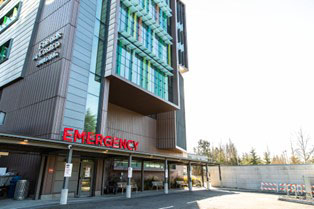Provider News
Seattle Children's Hospital Volumes
April 3, 2024
Seattle Children’s continues to see high numbers of pediatric patients with mental and behavioral health emergencies who require care in our Emergency Department and/or psychiatric inpatient unit.
How You Can Help
 Please continue to identify and manage lower-acuity complaints in outpatient settings, including urgent care, to help maintain ED capacity for higher-acuity concerns. Please see our Healthcare Professionals site for Resources for Community Providers.
Please continue to identify and manage lower-acuity complaints in outpatient settings, including urgent care, to help maintain ED capacity for higher-acuity concerns. Please see our Healthcare Professionals site for Resources for Community Providers.
- Before sending your patient to the ED, contact our Mission Control team with as much notice as possible at 206-987-8899. This helps us plan for your patient’s arrival. In appropriate instances, we may be able to directly admit your patient to the hospital or arrange an urgent ambulatory clinic visit in lieu of an ED visit.
- Please be aware that our inpatient Psychiatry and Behavioral Medicine Unit (PBMU) has limited capacity for new patients. At this time, we are referring pediatric patients requiring psychiatric inpatient admission to appropriate facilities in Washington State, as needed.
- Help set realistic expectations about an ED visit and/or inpatient admission with children, families, and partners.
- An ED visit for mental or behavioral health typically involves an evaluation to determine if the child needs an inpatient psychiatric admission or is appropriate to discharge home. Patients and families should be prepared for potentially longer wait times.
- As noted earlier, referrals to the PBMU will experience significant wait times and may not result in admission; we are asking all external partners to consider referring patients who need inpatient admission to all appropriate inpatient pediatric psychiatric facilities in Washington and consistently re-assess need for inpatient admission.
- Patients seen in our ED who need inpatient psychiatric admission will be referred to all appropriate inpatient pediatric psychiatric facilities in Washington.
- An inpatient psychiatric admission is typically 5 to 10 days and focused on acute crisis stabilization. It is not a long-term placement.
Mental and Behavioral Health Resources for Providers
These resources may help you manage patients in primary or urgent care instead of sending to the ED:
- The Partnership Access Line (PAL) supports primary care providers (doctors, nurse practitioners and physician assistants) with questions about mental and behavioral health care such as diagnostic clarification, medication adjustment or treatment planning. Our child and adolescent psychiatrists are available to consult during business hours.
- The Washington Mental Health Referral Service connects patients and families with evidence-supported outpatient mental and behavioral health services in their community. This free telephone-based referral service provides thorough mental and behavioral health referrals for children and teens 17 and younger from across Washington.
- Seattle Children’s First Approach Skills Training (FAST) programs are designed to provide brief, evidence-based behavioral therapy for youth and families with common mental and behavioral health concerns in settings such as primary care clinics or schools, where longer-term treatment is not typically provided. Program materials, as well as engagement and assessment tools for clinicians, are available on the Seattle Children’s FAST website.
- Seattle Children’s online mental and behavioral health hub: Provides resources for families and caregivers to reference for their child’s mental and behavioral health and wellness. You can learn about common mental and behavioral health problems in children and teens, how to recognize the signs of a problem and crisis and how to help your child or teen as well as what services are available.
- Family Resource Center – Child Mind Institute: Provides information for families and caregivers to help support children who are struggling with mental and behavioral health or learning challenges.
- Algorithms and other PCP resources for 65+ conditions